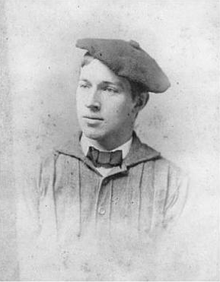| Frank Stephens | |
|---|---|
 | |
| Born | George Francis Stephens December 28, 1859 Rahway, New Jersey |
| Died | June 16, 1935 Gilpin Point, Maryland |
| Known for | Community planning |
| Notable work | Arden, Delaware |
| Movement | Georgism, Arts and Crafts Movement |
George Francis Stephens (1859–1935) was an American sculptor, political activist and co-founder of a utopian single-tax community in Arden, Delaware.
Early life, education and family
Stephens was born December 28, 1859, in Rahway, New Jersey, to Henry Louis Stephens and Charlotte Ann Wevil. He briefly attended Rutgers College in New Brunswick, New Jersey, and entered the Pennsylvania Academy of the Fine Arts (PAFA) in 1875, where he studied under Thomas Eakins at various times between 1879 and 1885. He served as Eakins' teaching assistant beginning in 1880, and married Eakins' sister Caroline "Caddie" Eakins on June 14, 1884. They had three children, Margaret, Donald, and Roger. Caroline died after giving birth in 1889. Stephens' second marriage was to Elenor Getty on November 29, 1905; they had 10 children.
Art career
Following art school, Stephens formed a Philadelphia decorative arts business with classmates Colin Campbell Cooper, Jr., Jesse Godley, and Walter J. Cunningham. He worked for several years on the sculpture of Philadelphia City Hall, and was an instructor in modeling at several art schools, including the Drexel Institute. He was a member of the Philadelphia Sketch Club from 1881 until his death in 1935.
Accusations against Eakins
On February 9, 1886, Stephens accused brother-in-law Thomas Eakins of sexual misconduct with his PAFA students and with his deceased sister Margaret. The charges ignited such a controversy that Eakins was forced to resign from PAFA.
Stephens, his cousin Charles Stephens, and Thomas Anshutz, all PAFA instructors, next took their accusations to the Philadelphia Sketch Club: "We hereby charge Mr. Thom Eakins with conduct unworthy of a gentleman & discreditable to this organization & ask his expulsion from the club." A committee investigated, concluding that: "Eakins has used his position as an artist and his authority as a teacher to commit certain trespasses on common decency and good morals." His honorary membership in the club was revoked.
The charges of sexual misconduct and incest were unproven, but Eakins's personal reputation was ruined, something from which he never totally recovered.
Single-tax movement
Stephens was influenced by the theories of Henry George, who argued in his 1879 publication Progress and Poverty for a more equitable distribution of wealth, through a single tax levied on the actual value of land irrespective of improvements a person might make. George platformed on this philosophy in his 1886 New York City mayoral bid, and despite losing was successful enough for a subsequent run. Stephens joined his campaign in 1895.
Stephens first came to Delaware along with William Lightfoot Price, a Philadelphia architect, in 1895-1896 during the single-tax campaign to win political control of the state. The single-taxers hoped that by gaining control of a small political entity they could put their principles into action and prove the legitimacy of Henry George's aims. Although the campaign failed — many activists (including Stephens) were jailed — but Price and Stephens did not give up their dream of creating a utopian community.
Founding Arden, Delaware
With the financial help of Joseph Fels, a wealthy soap manufacturer and single-tax proponent, Stephens purchased the Derrickson property, a 162 acres (0.66 km) farm six miles north of Wilmington on June 12, 1900. Price and Stephens named their newly founded community after the idyllic Forest of Arden from Shakespeare's As You Like It, and adopted "You are welcome hither" (a line from King Lear) as the community motto because they wanted the village to be a place open to people of all economic levels and political views.
Along with their economic philosophy, Price and Stephens shared a belief in the principles of William Morris, John Ruskin, and the Arts and Crafts Movement. Morris, an Englishman, rebelled against modern cities and industry, advocating a return to craft production, good design, and village life. Price designed a town plan that provided communal open space, encouraged people to mingle with their neighbors, and preserved the woodlands along Naaman's Creek.
Stephens continued to live and lead in Arden for three decades after its founding, earning the nickname "Patro" (a word meaning "Father" in Esperanto) by the villagers. He died June 16, 1935 at age 75 in Gilpin Point, Maryland (another Georgian community he had helped start).
References
- ^ "Descendants of Henry Lewis Stephens and Charlotte Ann Wevill".
- ^ Edwards, Eliza Harvey (1993). "Arden: the architecture and planning of a Delaware utopia". University of Pennsylvania (Master's thesis).
- Adams, Henry (2005). Eakins revealed. Oxford University Press. p. 62.
- "The Philadelphia Sketch Club - Archives & Permanent Collection". Archived from the original on 2008-12-02.
- Kirkpatrick, Sydney D. (2006). The Revenge of Thomas Eakins. Yale University Press. p. 11. ISBN 9780300108552.
- Kathleen A. Foster and Cheryl Leibold, Writing About Eakins (Philadelphia: University of Pennsylvania Press, 1989), p. 220.
- "PSC". Archived from the original on 2008-12-02. Retrieved 2008-12-01.
- Henry Adams, Eakins Revealed (New York: Oxford University Press, 2005), p. 60.
- ^ Shields, Jerry. "Forgotten Writings of Arden's Frank Stephens". Collecting Delaware Books.
- Thomas, George E. and Robert Venturi (2000). William L. Price. Princeton Architectural Press. ISBN 9781568982205.
- Frank, Bill (1986). "Arden: From Theory to Practice". Archived from the original on 2010-11-21.
- Sculptors from Pennsylvania
- Pennsylvania Academy of the Fine Arts alumni
- Pennsylvania Academy of the Fine Arts faculty
- Students of Thomas Eakins
- Georgists
- 1859 births
- 1935 deaths
- People from Rahway, New Jersey
- Sculptors from New Jersey
- 20th-century American sculptors
- 20th-century American male artists
- 19th-century American sculptors
- 19th-century American male artists
- American male sculptors